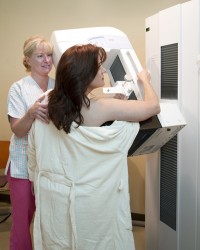As part of a rigorous evaluation and quality compliance program from the National Accreditation Program for Breast Centers (NAPBC), the Vanderbilt Breast Center has been awarded a three-year full accreditation.
The NAPBC, a program of the American College of Surgeons, represents a consortium of national organizations dedicated to the improvement of the quality of care and monitoring of outcomes of patients with diseases of the breast.

NAPBC accreditation challenges breast cancer centers to enhance the care they provide by addressing patient-centered needs and measuring the quality of the care they deliver against national standards.
Each breast center must undergo an in-depth evaluation and review of its performance and compliance with NAPBC Standards. To maintain accreditation, centers must monitor compliance with NAPBC Standards to ensure quality care, and undergo an on-site review every three years.
The Vanderbilt Breast Center, located at Vanderbilt Health One Hundred Oaks, is among a small number of breast centers in Tennessee to receive this recognition for high quality care.
“We are very proud to receive the three-year full accreditation from the NAPBC,” said Ingrid Meszoely, M.D., associate professor of Surgical Oncology and clinical director of the Vanderbilt Breast Center.
“We have a tremendously dedicated staff of professionals representing multiple health care disciplines, and this full accreditation designation is an important validation of the quality of care that the staff provides to our patients.”
At the Vanderbilt Breast Center, each breast patient is cared for by an interdisciplinary team of health care providers who explain the treatment options available for cancer and benign breast diseases and coordinate services so that patient care is streamlined.
“As we learn more about the types of gene mutations that occur in many breast cancers, treatment has become very complex and we have adopted new evidence-based treatment techniques to provide personalized care for our patients,” Meszoely said.
The NAPBC board has defined 28 program standards and 17 components of care that collectively provide the most efficient and contemporary care available for patients diagnosed with diseases of the breast. These program components include breast imaging, disease staging, biopsies, surgical quality, nursing, genetic evaluation, radiation oncology, patient education and support and access to clinical trials.
“We are especially pleased that the NAPBC evaluators recognized our focus on quantitative metrics and data-driven quality improvement processes,” said John Huff, M.D., chief of the Section of Breast Imaging and imaging director for the Vanderbilt Breast Center.
“We are proud to be recognized for clinical and imaging excellence by both the American College of Radiology as a Breast Imaging Center of Excellence as well as now by the American College of Surgeons with this accreditation from the NAPBC.”
Screening mammograms and diagnostic imaging are provided at the Vanderbilt Breast Center and breast cancer patients receiving chemotherapy are treated in the One Hundred Oaks Infusion Center. Patients are followed by a patient navigator who helps track and manage access to care and patients can meet with their care providers on-site at One Hundred Oaks.












